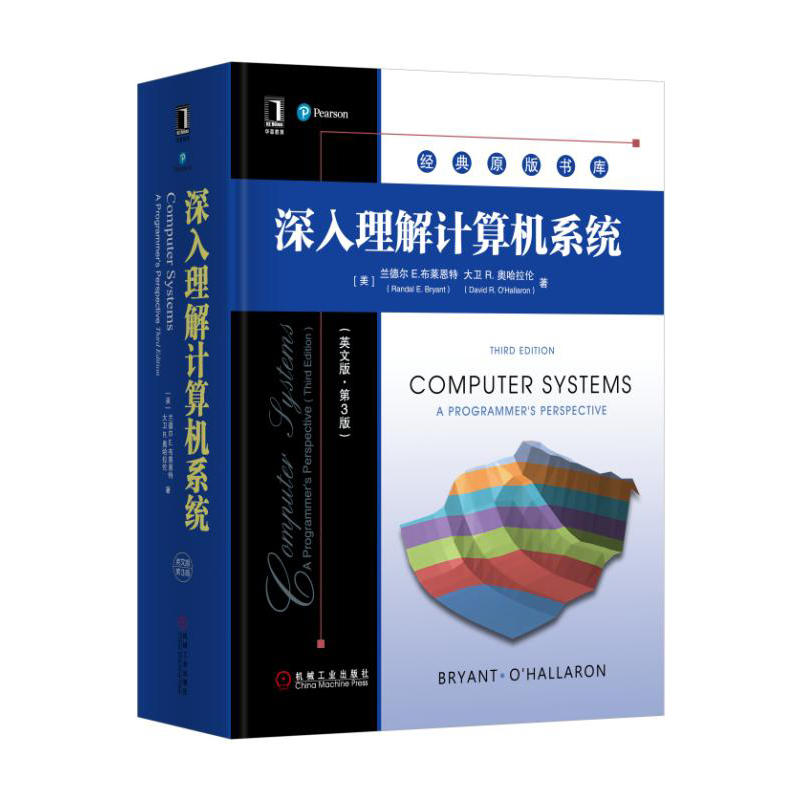
包邮深入理解计算机系统-(英文版.第3版)

- ISBN:9787111561279
- 装帧:一般胶版纸
- 册数:暂无
- 重量:暂无
- 开本:32开
- 页数:1045
- 出版时间:2017-03-01
- 条形码:9787111561279 ; 978-7-111-56127-9
本书特色
本书从程序员的视角详细阐述计算机系统的本质概念,并展示这些概念如何实实在在地影响应用程序的正确性、性能和实用性。全书共12章,主要包括信息的表示和处理、程序的机器级表示、处理器体系结构、优化程序性能、存储器层次结构、链接、异常控制流、虚拟存储器、系统级I/O、网络编程、并发编程等内容。书中提供了大量的例子和练习题,并给出部分答案,有助于读者加深对正文所述概念和知识的理解。
内容简介
本书系统地介绍了整个计算机系统的工作原理,可帮助读者系统性地理解计算机如何执行程序、存储信息和通信;全书包括9个配套的实验,读者在新鲜有趣的实验中理解系统原理,培养动手能力;本书紧跟时代的发展,加入了x86-64指令集等新技术内容;该教材从程序员的角度看待计算机系统,重点讨论系统的不同结构对于上层应用软件编写、执行和数据存储的影响,以培养程序员在更广阔空间应用计算机系统知识的能力。
目录
Preface xix About the Authors xxxv
1
A Tour of Computer Systems 1
1.1Information Is Bits Context 3
1.2Programs Are Translated by Other Programs into Different Forms 4
1.3It Pays to Understand How Compilation Systems Work 6
1.4Processors Read and Interpret Instructions Stored in Memory 7
1.4.1Hardware Organization of a System 8
1.4.2Running the helloProgram 10
1.5Caches Matter 11
1.6Storage Devices Form a Hierarchy 14
1.7The Operating System Manages the Hardware 14
1.7.1Processes 15
1.7.2Threads 17
1.7.3Virtual Memory 18
1.7.4Files 19
1.8Systems Communicate with Other Systems Using Networks 19
1.9Important Themes 22
1.9.1Amdahl’s Law 22
1.9.2Concurrency and Parallelism 24
1.9.3The Importance of Abstractions in Computer Systems 26
1.10Summary 27 Bibliographic Notes 28 Solutions to Practice Problems 28
Part I Program Structure and Execution
2
Representing and Manipulating Information 31
2.1Information Storage 34
2.1.1Hexadecimal Notation 36
2.1.2Data Sizes 39
2.1.3 Addressing and Byte Ordering 42
2.1.4 Representing Strings 49
2.1.5 Representing Code 49
2.1.6 Introduction to Boolean Algebra 50
2.1.7 Bit-Level Operations in C 54
2.1.8 Logical Operations in C 56
2.1.9 Shift Operations in C 57
2.2 Integer Representations 59
2.2.1 Integral Data Types 60
2.2.2 Unsigned Encodings 62
2.2.3 Two’s-Complement Encodings 64
2.2.4 Conversions between Signed and Unsigned 70
2.2.5 Signed versus Unsigned in C 74
2.2.6 Expanding the Bit Representation of a Number 76
2.2.7 Truncating Numbers 81
2.2.8 Advice on Signed versus Unsigned 83
2.3 Integer Arithmetic 84
2.3.1 Unsigned Addition 84
2.3.2 Two’s-Complement Addition 90
2.3.3 Two’s-Complement Negation 95
2.3.4 Unsigned Multiplication 96
2.3.5 Two’s-Complement Multiplication 97
2.3.6 Multiplying by Constants 101
2.3.7 Dividing by Powers of 2 103
2.3.8 Final Thoughts on Integer Arithmetic 107
2.4 Floating Point 108
2.4.1 Fractional Binary Numbers 109
2.4.2 IEEE Floating-Point Representation 112
2.4.3 Example Numbers 115
2.4.4 Rounding 120
2.4.5 Floating-Point Operations 122
2.4.6 Floating Point in C 124
2.5 Summary 126
Bibliographic Notes 127
Homework Problems 128
Solutions to Practice Problems 143
3
Machine-Level Representation of Programs 163
3.1 A Historical Perspective 166
3.2Program Encodings 169
3.2.1Machine-Level Code 170
3.2.2Code Examples 172
3.2.3Notes on Formatting 175
3.3Data Formats 177
3.4Accessing Information 179
3.4.1Operand Speci.ers 180
3.4.2Data Movement Instructions 182
3.4.3Data Movement Example 186
3.4.4Pushing and Popping Stack Data 189
3.5Arithmetic and Logical Operations 191
3.5.1Load Effective Address 191
3.5.2Unary and Binary Operations 194
3.5.3Shift Operations 194
3.5.4Discussion 196
3.5.5Special Arithmetic Operations 197
3.6Control 200
3.6.1Condition Codes 201
3.6.2Accessing the Condition Codes 202
3.6.3Jump Instructions 205
3.6.4Jump Instruction Encodings 207
3.6.5Implementing Conditional Branches withConditional Control 209
3.6.6Implementing Conditional Branches withConditional Moves 214
3.6.7Loops 220
3.6.8Switch Statements 232
3.7Procedures 238
3.7.1The Run-Time Stack 239
3.7.2Control Transfer 241
3.7.3Data Transfer 245
3.7.4Local Storage on the Stack 248
3.7.5Local Storage in Registers 251
3.7.6Recursive Procedures 253
3.8Array Allocation and Access 255
3.8.1Basic Principles 255
3.8.2Pointer Arithmetic 257
3.8.3Nested Arrays 258
3.8.4Fixed-Size Arrays 260
3.8.5Variable-Size Arrays 262
3.9 Heterogeneous Data Structures 265
3.9.1 Structures 265
3.9.2 Unions 269
3.9.3 Data Alignment 273
3.10 Combining Control and Data in Machine-Level Programs 276
3.10.1 Understanding Pointers 277
3.10.2 Life in the Real World: Using the gdbDebugger 279
3.10.3 Out-of-Bounds Memory References and Buffer Over.ow 279
3.10.4 Thwarting Buffer Over.ow Attacks 284
3.10.5 Supporting Variable-S
作者简介
Randal E. Bryant
1973年获得密歇根大学学士学位,随即就读麻省理工学院的研究生院,并在1981年获得计算机博士学位。从1984年至今一直任教于卡内基-梅隆大学,现在是卡内基-梅隆大学计算机科学学院院长、教授,同时受邀任教于工学院电子与计算机工程系。他还是ACM院士、IEEE院士和美国国家工程院院士。其研究成果获得过数项大奖,其中包括Semiconductor Research Corporation颁发的两个发明荣誉奖和一个技术成就奖,ACM颁发的Kanellakis理论与实践奖,还有IEEE颁发的W. R. G. Baker奖、Emmanuel Piore奖和Phil Kaufman奖。
David R. O,Hallaron
拥有弗吉尼亚大学计算机科学博士学位,现为Intel匹兹堡实验室主任,卡内基-梅隆大学计算机科学和电子与计算机工程副教授。他曾获得卡内基-梅隆大学计算机科学学院颁发的Herbert Simon杰出教学奖,并同Quake项目中其他成员一起获得了高性能计算领域中的高国际奖项——Gordon Bell奖。
-

厚黑学(九品)
¥27.2¥68.0 -

断代(八品)
¥16.8¥42.0 -

落洼物语
¥12.0¥28.0 -

毛泽东思想和中国特色社会主义理论体系概论(2021年版)
¥11.0¥25.0 -

中医基础理论
¥51.7¥59.0 -

生理学·全国中医药行业高等教育“十四五”规划教材
¥68.1¥78.0 -

新世纪高等学校教材 心理学基础课系列教材普通心理学(第5版)/彭聃龄
¥39.2¥78.0 -

中医学概论(新世纪第二版)(本科教材)
¥77.4¥90.0 -

习近平总书记教育重要论述讲义
¥19.3¥35.0 -

高等数学-上册-第七版
¥25.3¥47.6 -

闯进数学世界――探秘历史名题
¥23.3¥32.8 -

钳工工艺与技能训练
¥33.5¥45.0 -

习近平新时代中国特色社会主义思想概论
¥23.3¥26.0 -

哲学导论
¥31.4¥62.0 -

无机化学·全国中医药行业高等教育“十四五”规划教材
¥66.4¥76.0 -

无机化学(第2版)/张祖德
¥43.9¥78.0 -

中国古代文学史 第二版 上册
¥32.3¥43.3 -

维吾尔语日常会话500句
¥7.7¥12.0 -

掩不住的阳光(八品)
¥12.8¥52.0 -

民法物权
¥47.2¥66.0











